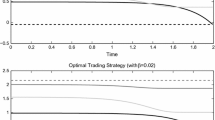Abstract
An optimal investment problem is solved for an insider who has access to noisy information related to a future stock price, but who does not know the stock price drift. The drift is filtered from a combination of price observations and the privileged information, fusing a partial information scenario with enlargement of filtration techniques. We apply a variant of the Kalman–Bucy filter to infer a signal, given a combination of an observation process and some additional information. This converts the combined partial and inside information model to a full information model, and the associated investment problem for HARA utility is explicitly solved via duality methods. We consider the cases in which the agent has information on the terminal value of the Brownian motion driving the stock, and on the terminal stock price itself. Comparisons are drawn with the classical partial information case without insider knowledge. The parameter uncertainty results in stock price inside information being more valuable than Brownian information, and perfect knowledge of the future stock price leads to infinite additional utility. This is in contrast to the conventional case in which the stock drift is assumed known, in which perfect information of any kind leads to unbounded additional utility, since stock price information is then indistinguishable from Brownian information.
Similar content being viewed by others
References
Aase, K.K., Bjuland, T., Øksendal, B.: Strategic insider trading equilibrium: a forward integration approach. Preprint (2007)
Amendinger J., Becherer D., Schweizer M.: A monetary value for initial information in portfolio optimization. Financ. Stoch. 7, 29–46 (2003)
Amendinger J., Imkeller P., Schweizer M.: Additional logarithmic utility of an insider. Stoch. Process. Appl. 75, 263–286 (1998)
Ankirchner S., Dereich S., Imkeller P.: The Shannon information of filtrations and the additional logarithmic utility of insiders. Ann. Probab. 34, 743–778 (2006)
Back K.: Insider trading in continuous time. Rev. Financ. Stud. 5, 387–409 (1992)
Baudoin F., Nguyen-Ngoc L.: The financial value of a weak information on a financial market. Financ. Stoch. 8, 415–435 (2004)
Björk T., Davis M.H.A., Landén C.: Optimal investment under partial information. Math. Methods Oper. Res. 71, 371–399 (2010)
Brendle S.: Portfolio selection under incomplete information. Stoch. Process. Appl. 116, 701–723 (2006)
Campi L.: Some results on quadratic hedging with insider trading. Stochastics 77, 327–348 (2005)
Campi L., Çetin U.: Insider trading in an equilibrium model with default: a passage from reduced-form to structural modelling. Financ. Stoch. 11, 591–602 (2007)
Cho K.-H.: Continuous auctions and insider trading: uniqueness and risk aversion. Financ. Stoch. 7, 47–71 (2003)
Corcuera J.M., Imkeller P., Kohatsu-Higa A., Nualart D.: Additional utility of insiders with imperfect dynamical information. Financ. Stoch. 8, 437–450 (2004)
Danilova A.: Stock market insider trading in continuous time with imperfect dynamic information. Stochastics 82, 111–131 (2010)
Hillairet C.: Comparison of insiders’ optimal strategies depending on the type of side-information. Stoch. Process. Appl. 115, 1603–1627 (2005)
Imkeller P.: Random times at which insiders can have free lunches. Stoch. Stoch. Rep. 74, 465–487 (2002)
Imkeller, P.: Malliavin’s calculus in insider models: additional utility and free lunches. Math. Financ. 13, 153–169 (2003). Conference on Applications of Malliavin Calculus in Finance, Rocquencourt, 2001
Jacod J.: Grossissement initial, hypotheèse (H’) et théorème de Girsanov. In: Jeulin, T., Yor, M. (eds) Grossissements de filtrations: exemples etapplications. Lecture Notes in Mathematics, vol. 1118, pp. 15–35. Springer-Verlag, Berlin (1985)
Karatzas I.: Lectures on the Mathematics of Finance. CRM Monograph Series, vol. 8. American Mathematical Society, Providence, RI (1997)
Kohatsu-Higa A., Sulem A.: Utility maximization in an insider influenced market. Math. Financ. 16, 153–179 (2006)
Kramkov D., Schachermayer W.: The asymptotic elasticity of utility functions and optimal investment in incomplete markets. Ann. Appl. Probab. 9, 904–950 (1999)
Kyle A.: Continuous auctions and insider trading. Econometrics 53, 1315–1336 (1985)
Lakner P.: Optimal trading strategy for an investor: the case of partial information. Stoch. Process. Appl. 76, 77–97 (1998)
Liptser R.S., Shiryaev A.N.: Statistics of Random Processes. I: General Theory, 2nd edn. Springer- Verlag, Berlin (2001)
Mansuy R., Yor M.: Random Times and Enlargements of Filtrations in a Brownian Setting. Lecture Notes in Mathematics, vol. 1873. Springer-Verlag, Berlin (2006)
Monoyios, M.: Utility-based valuation and hedging of basis risk with partial information. Appl. Math. Financ. (2010)
Pham H., Quenez M.-C.: Optimal portfolio in partially observed stochastic volatility models. Ann. Appl. Probab. 11, 210–238 (2001)
Pikovsky I., Karatzas I.: Anticipative portfolio optimization. Adv. Appl. Probab. 28, 1095–1122 (1996)
Rogers L.C.G.: The relaxed investor and parameter uncertainty. Financ. Stoch. 5, 131–154 (2001)
Xiong J., Zhou X.Y.: Mean-variance portfolio selection under partial information. SIAM J. Control Optim. 46, 156–175 (2007)
Yor, M.: Some Aspects of Brownian Motion. Part II, Lectures in Mathematics ETH Zürich, Birkhäuser Verlag, Basel (1997). (Some recent martingale problems)
Author information
Authors and Affiliations
Corresponding author
Rights and permissions
About this article
Cite this article
Danilova, A., Monoyios, M. & Ng, A. Optimal investment with inside information and parameter uncertainty. Math Finan Econ 3, 13–38 (2010). https://doi.org/10.1007/s11579-010-0025-y
Received:
Accepted:
Published:
Issue Date:
DOI: https://doi.org/10.1007/s11579-010-0025-y




